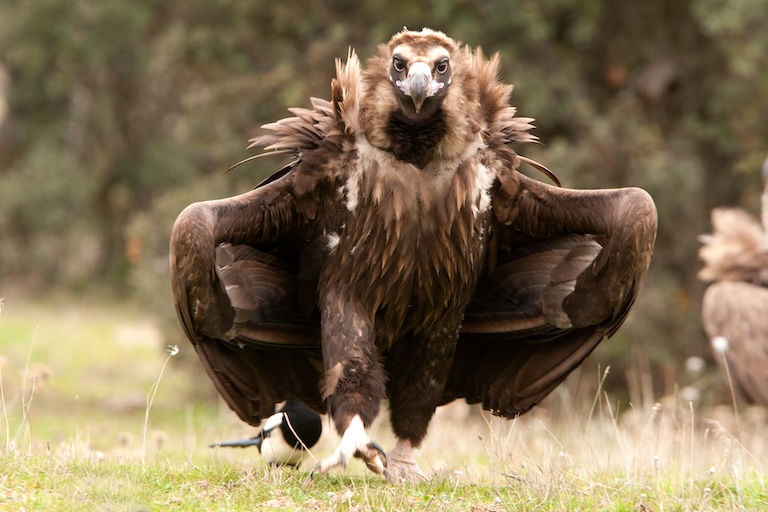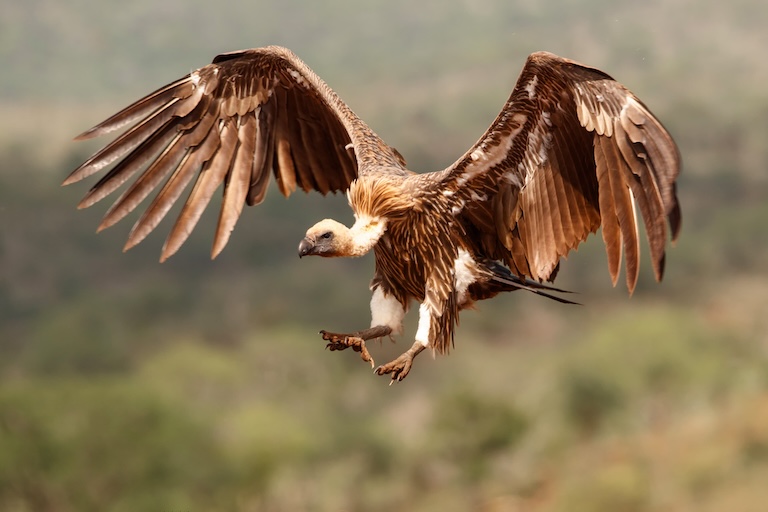Vulture Profile
Vultures are some of the most iconic and infamous birds of our time.
They’re known for circling, ominously above dehydrated cowboys; inspiring the evilest of self-proclaimed crystal guardians; and spending their time squabbling excitedly over flesh that should have gone in the freezer over a week ago.
But is there more to them than this slovenly and bacteria-ridden existence? Don’t worry, that’s a rhetorical question. The answer is: yes! And we’re here to champion that for you right now.

Vulture Facts Overview
| Habitat: | Mostly open grasslands and savanna. |
| Location: | Europe, Africa, Asia and the Americas |
| Lifespan: | Up to 30 years |
| Size: | From 72 cm to |
| Weight: | Up to 18 kg |
| Colour: | Brown and blacks mostly; some like the King vulture have vibrant, colourful features. |
| Diet: | Mostly carrion, some bone, some even eat fruit |
| Predators: | Hyenas, lions, larger raptors |
| Top Speed: | Up to 85 km/h (53 mph) |
| No. of Species: | 32 |
| Conservation Status: | Many are Critically Endangered |
Vultures are more than just a band, they’re a way of life. They come in many shapes, colours and sizes but the general theme is death and this is what gives us the willies about them.
But much like a square-headed goth mortician, the unsettling nature of the vulture represents a vital role in our community: the removal of our corpses.
And this task is not only critical, it is also highly specialised, and few animals other than vultures can do it.
Interesting Vulture Facts
1. They’re not a single thing
Vultures are two groups of birds from the hawk order of Accipitriformes.
Within that order sits most of the aerial killers of the vertebrate world, including hawks (obvs), eagles, harriers, owls, and kites (but not falcons because they’re apparently parrots for some reason!)
The last group within this order is less of an aerial predator and more of a dirty rotten scoundrel, the vulture. But this term is not in reference to any specific genus or even family, as the term really better describes a niche than the animals that fill it.
This niche is the carrion-feeders, and they’re summed up in to the Old World vultures and the New World vultures, who are member of unrelated families within the order. The Old World vultures are in the Accipitridae family, but they’re not alone here: pretty much all of those aforementioned raptors are in that family, too, which leaves vultures to settle for two subfamilies within it.
One subfamily is related to hawks, and the other is more related to the serpent eagles, so even these two aren’t the closest relatives of one another, but hop over the Atlantic and they get even more distantly related. New world vultures, actually do fill their own family but it’s totally unrelated to the others.
So, what groups them together is not their taxonomy, but their habits, and both New World and Old-World vultures are typically very large scavengers that feed primarily on mammal meat and the flesh of other large animals. And we don’t like this much.

2. They’re rather ugly
Vultures have a reputation for being unpleasant animals, and as we’ll touch on shortly, there’s good reason for this, though it’s a fundamental misunderstanding of their roles in the ecosystems.
Vultures commonly have bald necks and heads, and this gives them the look of an evil Skeksis from Dark Crystal. This bald neck comes as an adaptation to some of the gross things like sticking their heads up the butt of a dead buffalo to feed on the soft internal tissues.
But vultures, while predominantly carrion-feeders, are much more than ugly, dirty old things; they are often specialists, able to eat bone or handle meat to rotten for most other animals to consume. The bearded vulture, for example, is the only vertebrate capable of sustaining itself entirely on bone, and most species have stomach acid ten times the strength of ours at our strongest.
Interestingly, despite what an old reference that Dark Crystal shoutout was, vultures in human culture go back even further.1
3. They’re ancient
Vultures and humans have a relationship that goes way back. Tibetan sky burials go back more than a thousand years, and there are some suggestions that the site of Stone Henge in the UK was used in the same way, 6000 years ago.
Back then, the ceremonial burying of the dead hadn’t made it onto the Isles, and archaeologists are confounded by a lack of evidence preserved in the ground of the people who lived there, so some have suggested that the henge itself would have acted as a morbid and ceremonial spot to leave the corpses of your loved ones so that they would be returned to the earth by way of bird and fox.
This approach continues to this day, and the tower of silence in the Zoroastrian literature shows us a very similar feature built by the Persians, some thousands of years later.
So, humans and vultures go back thousands of years, but our ecological roles intertwine for the millions of years before that, and it’s likely that without vultures, we – along with most other large animals – wouldn’t be here. 2
4. They’re ecosystem engineers
Vultures, with their habits that make us feel sick, may appear to be unhygienic animals, but in reality, it’s quite the opposite.
These cleanup crews are responsible for removing a vast amount of the pathogens that would otherwise thrive and infect us and the animals around us with diseases. They do this with their aforementioned stomach acid, as well as a bunch of other resistances to disease that allow them to thrive on food that would likely kill us outright.
Again, this is a generalisation, because as we mentioned, vultures are very varied, and the palm nut vulture eats mostly fruit. But on the whole, the term vulture represents less of a monophyletic line of birds, and more an occupation: that of a forensic biohazard sanitation service and one that goes grossly under our radar.
Vultures, and animals like them, keep our communities safe and clean and should be respected as such! 3
5. They’re big
Vultures are also some of the largest flying animals, with the condors reaching wingspans of over three metres. With these enormous wings, they can ride winds for hours, perhaps even days at a time, and some can even reach alarming speeds of upwards of 80 km/h.
This size, and their habit of eating meat has created two problems and we will deal with them one at a time. The first is that they get very hot, and being covered in feathers, they can’t sweat.
The second is that they make livestock farmers feel threatened and are often misidentified as the killers of farm animals.
So, first things first, here’s how they deal with the heat.
6. They pee on themselves
Vultures don’t have sweat, and they have very few areas of the body where the skin is in contact with the air directly.
The legs are the heat sink of choice, and in the absence of sweat, they release urine instead. Peeing on their legs creates the same evaporative cooling effect that many mammals get from sweating, and helps them stay cool.
Unfortunately, this doesn’t combat their persecution by farmers. 4
7. They’re in serious trouble
Vultures in general are some of the most threatened animals in the Old World. In Africa and Asia, they are blamed for killing livestock and they are poisoned or shot across much of their range.
But far more serious is the threat of poisoning from the livestock meat itself. Farm animals are commonly treated with the anti-inflammatory drugs diclofenac, which is well tolerated in mammals but lethally toxic to birds.
So, there has been a decline in some vulture species of up to 99%, and while governments and NGOs have tried to introduce alternative drugs, rural farmers typically don’t understand or care about the bigger picture, and with diclofenac being so cheap, it’s almost impossible to replace.
Of course, this is a catastrophe for the vultures, but it’s also deadly to the people who lived with them. In their absence, dogs fill the niche and dogs then spread rabies and other diseases to the human populations. Among other factors, the removal of vultures has been attributed to the deaths of over 500,000 humans in India alone and this pattern is being repeated in Africa, too.
Conservationists have a hard task ahead of them to celebrate vultures as significant, critically important and respectable animals in order to get public opinion away from the fear and disgust and towards an attitude of sustainability and recovery.
These are incredible birds in both ecological and biological contexts, and they need our help!5

Vulture Fact-File Summary
Scientific Classification
| Kingdom: | Animalia |
| Phylum: | Chordata |
| Class: | Aves |
| Order: | Accipitriformes |
| Family: | Accipitridae and Cathartidae |
| Genus: | 7 genera |
| Species Name: | 23 species |
Fact Sources & References
- “The pH of a vulture’s stomach is closest to which of these?”, WWF.
- (2025), “More than scavengers: how vultures influenced cultures and religions”, Vulture Conservation Foundation.
- Santangeli et al. (2024), “The global contribution of vultures towards ecosystem services and sustainability: An experts’ perspective”, National Library of Medicine.
- , “Turkey Vulture”, The Peregrine Fund.
- Soutik Biswas (2024), “How decline of Indian vultures led to 500,000 human deaths”, BBC.
